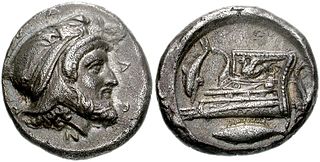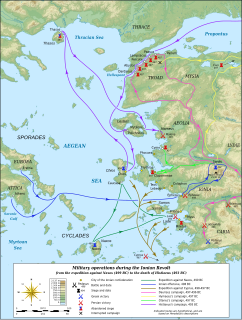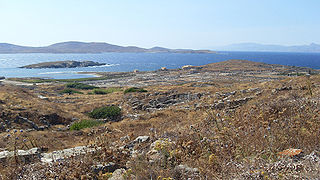 W
WThe Battle of Artemisium, or Battle of Artemision, was a series of naval engagements over three days during the second Persian invasion of Greece. The battle took place simultaneously with the land battle at Thermopylae, in August or September 480 BC, off the coast of Euboea and was fought between an alliance of Greek city-states, including Sparta, Athens, Corinth and others, and the Persian Empire of Xerxes I.
 W
WThe Battle of Cnidus was a military operation conducted in 394 BC by the Achaemenid Empire against the Spartan naval fleet during the Corinthian War. A fleet under the joint command of Pharnabazus and former Athenian admiral, Conon, destroyed the Spartan fleet led by the inexperienced Peisander, ending Sparta's brief bid for naval supremacy.
 W
WThe Battle of Lade was a naval battle which occurred during the Ionian Revolt, in 494 BC. It was fought between an alliance of the Ionian cities and the Persian Empire of Darius the Great, and resulted in a decisive victory for the Persians which all but ended the revolt.
 W
WThe Battle of Salamis was a naval battle fought between an alliance of Greek city-states under Themistocles, and the Persian Empire under King Xerxes in 480 BC. It resulted in a decisive victory for the outnumbered Greeks. The battle was fought in the straits between the mainland and Salamis, an island in the Saronic Gulf near Athens, and marked the high point of the second Persian invasion of Greece.
 W
WThe Battle of the Eurymedon was a double battle, taking place both on water and land, between the Delian League of Athens and her Allies, and the Persian Empire of Xerxes I. It took place in either 469 or 466 BCE, in the vicinity of the mouth of the Eurymedon River in Pamphylia, Asia Minor. It forms part of the Wars of the Delian League, itself part of the larger Greco-Persian Wars.
 W
WThe Ionian Revolt, and associated revolts in Aeolis, Doris, Cyprus and Caria, were military rebellions by several Greek regions of Asia Minor against Persian rule, lasting from 499 BC to 493 BC. At the heart of the rebellion was the dissatisfaction of the Greek cities of Asia Minor with the tyrants appointed by Persia to rule them, along with the individual actions of two Milesian tyrants, Histiaeus and Aristagoras. The cities of Ionia had been conquered by Persia around 540 BC, and thereafter were ruled by native tyrants, nominated by the Persian satrap in Sardis. In 499 BC, the tyrant of Miletus, Aristagoras, launched a joint expedition with the Persian satrap Artaphernes to conquer Naxos, in an attempt to bolster his position. The mission was a debacle, and sensing his imminent removal as tyrant, Aristagoras chose to incite the whole of Ionia into rebellion against the Persian king Darius the Great.
 W
WThe Battle of Qarqar was fought in 853 BCE when the army of the Neo-Assyrian Empire led by Emperor Shalmaneser III encountered an allied army of eleven kings at Qarqar led by Hadadezer, called in Assyrian Adad-idir and possibly to be identified with King Benhadad II of Aram-Damascus; and Ahab, king of Israel. This battle, fought during the 854–846 BCE Assyrian conquest of Aram, is notable for having a larger number of combatants than any previous battle, and for being the first instance in which some peoples enter recorded history, such as the Arabs. The battle is recorded on the Kurkh Monoliths.
 W
WThe Siege of Tyre was waged by Nebuchadnezzar II of Babylon for 13 years from 586 to 573 BC. The siege of Tyre, in Phoenicia, has a significant connection to the Book of Ezekiel where it was prophesied that the city would fall to Babylonian forces after a years-long siege.
 W
WThe siege of Tyre was orchestrated by Alexander the Great in 332 BC during his campaigns against the Persians. The Macedonian army was unable to capture the city, which was a strategic coastal base on the Mediterranean Sea, through conventional means because it was on an island and had walls right up to the sea. Alexander responded to this problem by first blockading and besieging Tyre for seven months, and then by building a causeway that allowed him to breach the fortifications.
 W
WThe Wars of the Delian League were a series of campaigns fought between the Delian League of Athens and her allies, and the Achaemenid Empire of Persia. These conflicts represent a continuation of the Greco-Persian Wars, after the Ionian Revolt and the first and second Persian invasions of Greece.